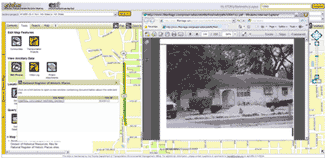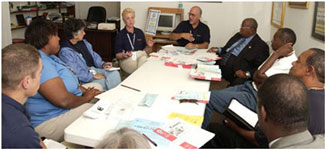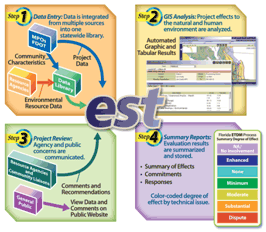FLORIDA DEPARTMENT OF TRANSPORTATION
Efficient Transportation Decision-Making (ETDM) Process
Program Description

ETDM screenshot showing residence in historic district.
(Source: Florida Department of Transportation.)
Program Benefits
- By front-loading historic preservation analyses (and other environmental analyses) into planning, using the ETDM program, project development moves more quickly, at less cost, and with fewer conflicts.
- Florida DOT (FDOT) has saved millions of dollars by not advancing projects that would have resulted in major conflicts with resource agencies and the public over environmental issues.
- One of the outcomes of the program is there is now greater engagement between FDOT and the resource agencies involving Section 106 reviews and other parts of the compliance process.
- The future outlook for the ETDM program is promising because the benefits of the program have been so great. It would be difficult for FDOT and the Florida division of FHWA to recreate another system that could be as rewarding.
Florida’s Efficient Transportation Decision-Making (ETDM) process assesses the potential environmental impacts of proposed transportation projects. This assessment, which is web-based, includes the consideration of historic preservation factors. Florida DOT (FDOT) and resource agencies participating in the program, including the Florida State Historic Preservation Office (SHPO), evaluate the potential impacts of a proposed project using an on-line “Environmental Screening Tool” (EST). All environmental evaluations and communications are performed, shared, and stored within the database.
The creation of ETDM required restructuring the State’s entire transportation planning process, in addition to establishing new dedicated funding for the program and the creation of new positions within the DOT to maintain ETDM. The program also required a commitment to develop and maintain a web-based GIS planning format.
Setting Up the Program

Environmental Technical Advisory Meeting.
(Source: Florida Department of Transportation.)
Two individuals, one within FDOT, the other within what was the FHWA regional office in Atlanta, served as the program’s original “champions.” These two “champions” identified ways to merge the agencies’ processes and programs, implement concurrent reviews, obtain early participation in the planning arena, and put in place the technology to make this all happen. Developing ETDM was a joint effort among FDOT, FHWA, and other state and Federal agencies, and local governments.
There are two ETDM components: technology and agency operating-agreements. The latter includes funding agreements, if needed, whereby FDOT provides financial assistance to a resource agency so they can fully participate in the ETDM program. The resource agency uses these funds to hire staff (part- and full-time), or to hire a consultant to assist them in implementing ETDM. Each agreement was developed agency-by-agency and tailored to the agencies’ processes. The agreements were signed by FHWA, FDOT, and the agencies.
During the first two years (1999 and 2000), FDOT, in cooperation with FHWA, initially used state money and Transportation Equity Act – Section 1309 funds to develop ETDM. FDOT put in place the agreements with the resource agencies and provided funding to these agencies as needed. Then, FDOT, again in cooperation with FHWA, used State funds and surface transportation program (STP) funds to implement ETDM. FDOT took the necessary funds for ETDM “off the top” of STP funding.
Initially, there was a big debate on how to implement ETDM. One option was as a pilot program or as a group of projects. The other option was to implement the program statewide. FDOT decided on the latter, holistic approach. When fully developed, FDOT would have in place a program that streamlines all of the DOT’s projects. This would not have been possible if FDOT focused on a group of projects or ran ETDM as a pilot program. Based on the positive results of implementing ETDM statewide, a holistic approach was the correct choice.
Challenges Encountered
Program Elements
- Historic Preservation
in Transportation Planning
- Historic Preservation
in Early Project Development
- Interagency Cooperation and Collaboration
- Geographic Information Systems
- Historic Property Database
- Historic Property Screening Tool
- Historic Property “Red Flags”
- Process for Tribal Consultation
- Streamlined Decision-Making Process
Trust among the participating agencies was the big initial issue. Developing a new process like ETDM was a learning experience for everyone.
Technology also was a challenge, since the tools needed to implement the program, such as the program and planning screens, did not exist. These tools had to be created from scratch. There also were no models for the type of resource agency agreements required for implementing ETDM.
Program Maintenance

Graphic showing steps in the ETDM environmental
screening tool evaluation process.
(Source: Florida Department of Transportation.)
FDOT has enhanced the program to support direct connectivity between the ETDM/EST system and the Florida Master Site File at the SHPO. The electronic site files at the SHPO can be accessed through the EST.
There have been no changes to how FDOT funds and maintains the program. Nor have there been any program-specific impacts from the current economic environment since the program has a dedicated funding source.
The one problem that has had an impact on the program relates to difficulty in retaining experienced personnel at the review agencies, which are FDOT’s partners. The ETDM system is integrated by design so impacts on one component of the system (the review agencies) affect other parts of the system.
Critical Factors for a Successful Program
Continued support and funding from the FHWA is vital to the program. FHWA was integral to the creation of the program and continues to be a major part of its success.
June 1, 2012

